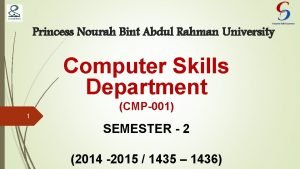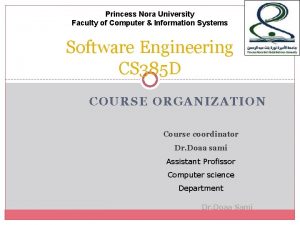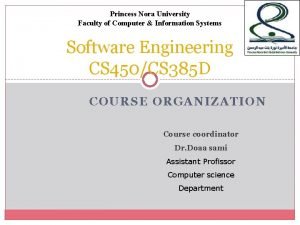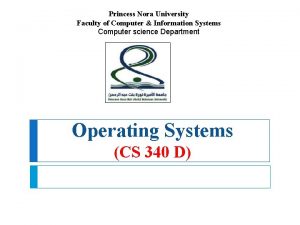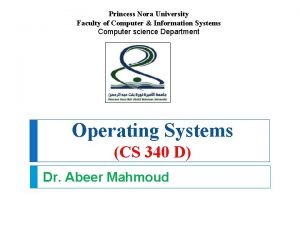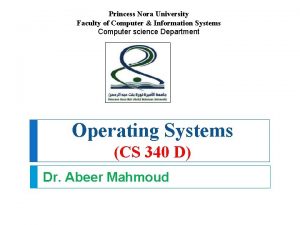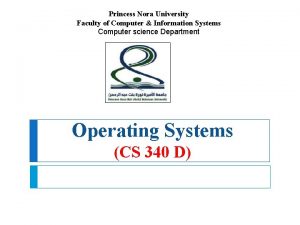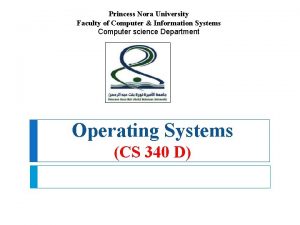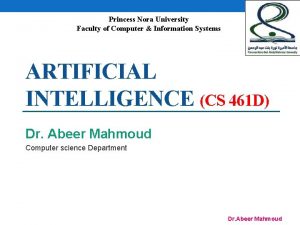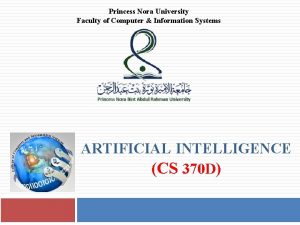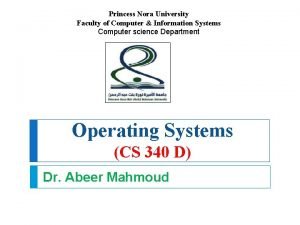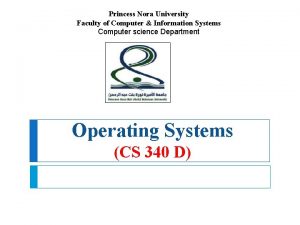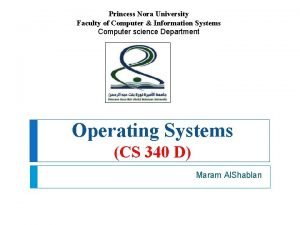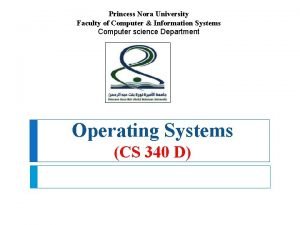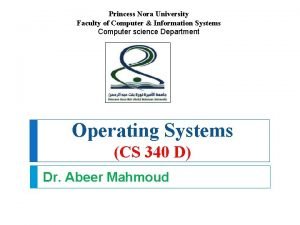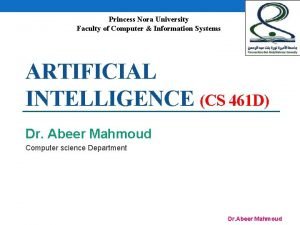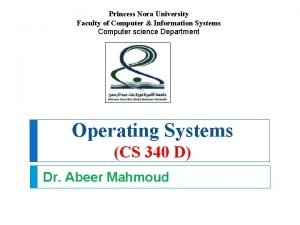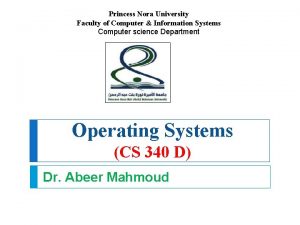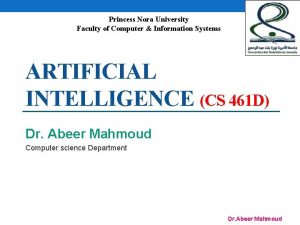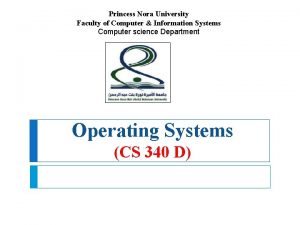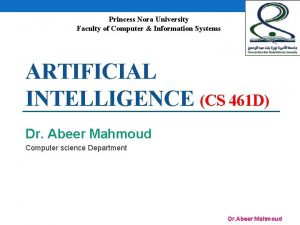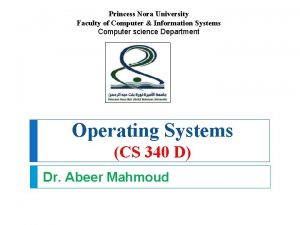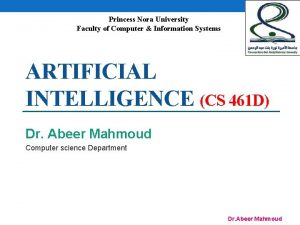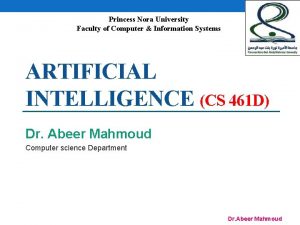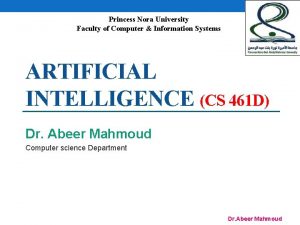Princess Nora University Faculty of Computer Information Systems


































- Slides: 34

Princess Nora University Faculty of Computer & Information Systems Computer science Department Operating Systems (CS 340 D)

(Chapter-11) File System Interface

Chapter 11: File System Interface 1. File Concept 2. Access Methods 3. Directory Structure 4. File Sharing 5. Protection 3

OBJECTIVES: Ø To explain the function of file systems Ø To describe the interfaces to file systems Ø To discuss file-system design tradeoffs, including access methods, file sharing, file locking, and directory structures Ø To explore file-system protection 4

Background 5

The file system consists of two distinct parts: 1. a collection of files, each storing related data, and 2. a directory structure, which organizes and provides information about all the files in the system. 6

File Concept �A file is a named collection of related information that is recorded on secondary storage. Ø Commonly, files represent programs (both source and object forms) and data. Data files may be numeric, alphabetic, alphanumeric, or binary. Ø Files may be free form, such as text files, or may be formatted rigidly. Ø Ø � The information in a file is defined by its creator. 7

File Concept (cont. ) Many different types of information may be stored in a file � Ø source programs, object programs, executable programs, numeric data, text, payroll records, graphic images, sound recordings, …. . Ø A file has a certain defined structure, which depends on its type. o o 8 e. g: A text file is a sequence of characters organized into lines A source file is a sequence of subroutines and functions, each of which is further organized as declarations followed by executable statements. An object file is a sequence of bytes organized into blocks understandable by the system’s linker. An executable file is a series of code sections that the loader can bring into memory and execute.

File Structure 9

File Structure � None - sequence of words, bytes � Simple record structure � Lines � Fixed length � Variable length � Complex Structures � Formatted document � Relocatable load file � Can simulate last two with first method by inserting appropriate control characters � Who decides: � Operating system � Program 10

File Attributes � Name – only information kept in human-readable form � Identifier – unique tag (number) identifies file within file system � Type – needed for systems that support different types � Location – pointer to file location on device � Size – current file size � Protection – controls who can do reading, writing, executing � Time, date, and user identification – data for protection, security, and usage monitoring � Information about files are kept in the directory structure, which is maintained on the disk 11

File Operations 12

File Operations � File is an abstract data type Create Two steps are necessary to create a file. Ø First, space in the file system must be found for the file how? Ø Second, an entry for the new file must be made in the directory. 13 Write To write a file, we make a system call specifying both the name of the file and the information to be written to the file. Ø Given the name of the file, the system searches the directory to find the file’s location. Ø The system must keep a write pointer to the location in the file where the next write is to take place. The write pointer mustbe updated whenever a write occurs.

File Operations (cont. ) Read To read from a file, we use a system call that 1. specifies file name and where (in memory) the next block of the file should be put. 2. the directory is searched for the associated entry, 3. the system keeps a read pointer to the location in the file where the next read is to take place. 4. Once the read has taken place, the read pointer is updated 14 Delete To delete a file ØProvide name and search the directory for it Ø Having found it, we release all file space, so that it can be reused by other files, and erase the directory entry

File Operations (cont. ) Truncating a file Ø The user may want to erase the contents of a file but keep its attributes. Rather than forcing the user to delete the file and then recreate it, this function allows all attributes to remain unchanged— except for file length—but lets the file be reset to length zero 15

File Types – Name, Extension 16

File Access Methods 17

Access Methods 1. Sequential Access 2. Direct Access (or relative access) ü Information in the file is ü A file is made up of fixed length processed in order, one of logical records that allow record after the other. programs to read and write records rapidly in no particular ü This mode of access is by order. far the most common ü read next, write next ü reset , no read after last write ü (rewrite) 18 ü read n, write n , position to n ü read next, write next , rewrite n n = relative block number

Simulation of Sequential Access on a Direct-access File 19

Directory and Disk Structure 20

Directory Structure q. A storage device can be used in its entirety for a file system. q It can also be subdivided into partitions (each partition can hold a file system) system q. Partitioning is useful for limiting the sizes of individual file systems, q. Partitions are also known as slices or (in the IBM world) minidisks. q Any entity containing a file system is generally known as a volume. 21

Directory Structure (cont. . ) q. Each volume can be thought of as a virtual disk. q. Each volume that contains a file system must also contain information about the files in the system. This is the device directory (simply as that directory) qrecords information—such as name, location, size, and type —for all files on that volume. file-system organization. 22

Directory Structure (cont. . ) �A collection of nodes containing information about all files Directory Files F 1 F 2 F 3 F 4 Fn Both the directory structure and the files reside on disk Backups of these two structures are kept on tapes 23

A Typical File-system Organization 24

Operations Performed on Directory � Search for a file � Create a file � Delete a file � List a directory � Rename a file � Traverse the file system 25

Organize the Directory (Logically) to Obtain � Efficiency – locating a file quickly � Naming – convenient to users � most common schemes for defining the logical structure of a directory. Ø Single-Level Directory Ø Two-Level Directory Ø Tree-Structured Directories 26

Single-Level Directory �A single directory for all users � The simplest structure � Limitation �Naming problem: when the number of files increases or when the system has more than one user. Since all files are in the same directory, they must have unique names e. g : The MS-DOS operating system allows only 11 -character file names; UNIX, in contrast, allows 255 characters. Ø Grouping problem : Keeping track of so many files is unaffordable 27

Two-Level Directory � Separate directory for each user n Path name n Can have the same file name for different user n Efficient searching n No grouping capability 28

Tree-Structured Directories n Efficient searching 29 n Grouping Capability

File Share and Protection 30

File Sharing � Sharing of files on multi-user systems is desirable � Sharing may be done through a protection scheme � On distributed systems, files may be shared across a network � Network File System (NFS) is a common distributed file-sharing method 31

File Sharing – Multiple Users � User IDs identify users, allowing permissions and protections to be per-user � Group IDs allow users to be in groups, permitting group access rights 32

Protection � File owner/creator should be able to control: � what can be done � by whom � Types of access � Read � Write � Execute � Append � Delete � List 33

Thank you End of Chapter 11 34 Dr. Abeer
 Gstt johor
Gstt johor Princess nora university
Princess nora university University of bridgeport engineering
University of bridgeport engineering University of bridgeport computer engineering
University of bridgeport computer engineering Computer science fsu
Computer science fsu Brown university computer science
Brown university computer science Herszon kherson maritime college of merchant marine fleet
Herszon kherson maritime college of merchant marine fleet Hubert kairuki memorial university faculty of medicine
Hubert kairuki memorial university faculty of medicine Semmelweis
Semmelweis Applied medical sciences
Applied medical sciences Faculty of business and economics mendel university in brno
Faculty of business and economics mendel university in brno Singularity university faculty
Singularity university faculty Semmelweis university faculty of medicine
Semmelweis university faculty of medicine Ascaris lumbricoides ova
Ascaris lumbricoides ova Feup university of porto
Feup university of porto Ldap cuni
Ldap cuni Faculty of veterinary medicine cairo university logo
Faculty of veterinary medicine cairo university logo Faculty of law of the university of zagreb
Faculty of law of the university of zagreb University of montenegro faculty of law
University of montenegro faculty of law University of kragujevac faculty of technical sciences
University of kragujevac faculty of technical sciences University of cologne faculty of management
University of cologne faculty of management Leading university tuition fees
Leading university tuition fees Hacettepe university faculty of medicine
Hacettepe university faculty of medicine Faculty of veterinary medicine - university of tehran
Faculty of veterinary medicine - university of tehran Semmelweis university faculty of medicine
Semmelweis university faculty of medicine Faculty of engineering lebanese university
Faculty of engineering lebanese university Concurrent education york
Concurrent education york Elearningunideb
Elearningunideb Clemson ece
Clemson ece Faculty of veterinary medicine cairo university
Faculty of veterinary medicine cairo university Faculty of mechanical engineering thammasat university
Faculty of mechanical engineering thammasat university Mendel university faculty of business and economics
Mendel university faculty of business and economics Masaryk university medical faculty
Masaryk university medical faculty Mahidol university public health
Mahidol university public health University of pecs faculty of health sciences
University of pecs faculty of health sciences
